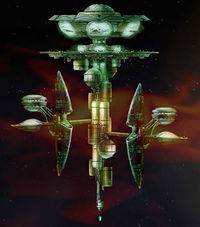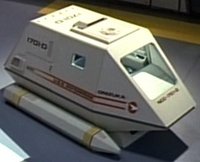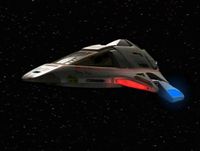Craft assigned to Deep Space 26: Difference between revisions
mNo edit summary |
m (Added missing category) |
||
| (6 intermediate revisions by 2 users not shown) | |||
| Line 1: | Line 1: | ||
{{ | {{DS26}} | ||
==Danube | ==Danube class Runabout== | ||
The Danube | [[Image:Danube1.jpg|left]] | ||
The [[Danube class]] runabouts are all named after rivers on Earth. In addition, like starships and unlike shuttlecraft, each runabout has its own registry number (ie. NCC or NX). | |||
The Danube Cclass was first commissioned by Starfleet in 2369 for use as a light multipurpose craft in situations that demanded a vessel more powerful than a standard shuttlecraft, but lower profile than a full-sized starship. With this flexibility, a runabout can be utilized as a long-range personnel/cargo transport, an agile mobile defense platform, or high-speed reconnaissance vehicle. | |||
Ideally, a runabout is piloted by two crewmembers, although one pilot will suffice. The bridge can accommodate up to four people. Small square viewscreens mounted within the forward corners of the cabin are used for video communication and ship status displays. In the center of the vessel lies a food replicator and a compact personnel transporter. The transporter is powerful enough to transport multiple personnel at once. | Ideally, a runabout is piloted by two crewmembers, although one pilot will suffice. The bridge can accommodate up to four people. Small square viewscreens mounted within the forward corners of the cabin are used for video communication and ship status displays. In the center of the vessel lies a food replicator and a compact personnel transporter. The transporter is powerful enough to transport multiple personnel at once. | ||
| Line 14: | Line 16: | ||
The runabout's highly modular platform allows easy configuration for a multitude of missions. Two such modules are the mission module and sensor pod. For defence, the runabout is armed with phasers and microtorpedoes. The microtorpedo launcher assembly is accessible via a hatch on the floor of the forward cabin. | The runabout's highly modular platform allows easy configuration for a multitude of missions. Two such modules are the mission module and sensor pod. For defence, the runabout is armed with phasers and microtorpedoes. The microtorpedo launcher assembly is accessible via a hatch on the floor of the forward cabin. | ||
The 6 runabouts assigned to Deep Space 26 were constructed specifically for that station. They have been assigned to Deep Space 26 and have seen no other duty as of yet. They were constructed at Starbase 118 at a rate of one a month and shipped to Deep Space 26 upon completion. They have no permanent crew, and are assigned personnel based upon their selected mission. | The 6 runabouts assigned to [[Deep Space 26]] were constructed specifically for that station. They have been assigned to Deep Space 26 and have seen no other duty as of yet. They were constructed at Starbase 118 at a rate of one a month and shipped to Deep Space 26 upon completion. They have no permanent crew, and are assigned personnel based upon their selected mission. | ||
*USS Euphrates (NCC-74601) | *[[USS Euphrates (NCC-74601)]] | ||
*USS Indus (NCC-74606) | *[[USS Indus|USS Indus (NCC-74606)]] | ||
*USS Mackenzie (NCC-74604) | *[[USS Mackenzie|USS Mackenzie (NCC-74604)]] | ||
*USS | *[[USS Paraña|USS Paraña (NCC-74605)]] | ||
*USS Tigris (NCC-74603) | *[[USS Tigris|USS Tigris (NCC-74603)]] | ||
*USS Thames (NCC-74607) | *[[USS Thames|USS Thames (NCC-74607)]] | ||
== Type-7 Shuttlecraft == | == Type-7 Shuttlecraft == | ||
[[Image:Type-7_small.jpg|left]] | |||
The type-7 shuttlecraft is a Starfleet auxiliary vehicle carried by starships in the 24th century. The type-7 shuttlecraft was introduced sometime prior to 2364. | The type-7 shuttlecraft is a Starfleet auxiliary vehicle carried by starships in the 24th century. The type-7 shuttlecraft was introduced sometime prior to 2364. | ||
| Line 37: | Line 40: | ||
The impulse engines are contained within nacelles on either side of the shuttlepod. The shuttle is also equipped with microfusion thrusters. Additional power is provided by krellide power cells. While normally specified as an impulse-driven craft, some of these vessels are outfitted with low-capacity warp drives. | The impulse engines are contained within nacelles on either side of the shuttlepod. The shuttle is also equipped with microfusion thrusters. Additional power is provided by krellide power cells. While normally specified as an impulse-driven craft, some of these vessels are outfitted with low-capacity warp drives. | ||
The normal flight crew is two pilots, although the shuttle can easily be operated by a single being. The ship also has a small cargo space, which can be used for carrying supplies. The cargo area was loaded and accessed through a hatch in the back of the craft. The type-15 is not normally outfitted to carry passengers, but a bench can be installed in the cargo area for a single crewperson. In this configuration, the cargo hatch serves as an emergency egress point, which can be blown away by explosive charges. | The normal flight crew is two pilots, although the shuttle can easily be operated by a single being. The ship also has a small cargo space, which can be used for carrying supplies. The cargo area was loaded and accessed through a hatch in the back of the craft. The type-15 is not normally outfitted to carry passengers, but a bench can be installed in the cargo area for a single crewperson. In this configuration, the cargo hatch serves as an emergency egress point, which can be blown away by explosive charges.<br><br> | ||
==Hawkeye class Scout Ships== | |||
[[Image:Hawkeye_class.jpg|left|200px]] | |||
Deep Space 26 also has a small complement of 8 [[Hawkeye class]] scout ships. The dual-crew vessels are primarily mobile sensor platforms, used to keep the station abreast of anything unusual in the war-riddled Expanse. | |||
[[Category:Deep Space 26|C]] | [[Category:Deep Space 26|C]] | ||
[[Category:Par'tha Expanse]] | |||
Latest revision as of 04:32, 14 June 2021
| Deep Space 26 | ||
|---|---|---|

| ||
| ||
Danube class Runabout
The Danube class runabouts are all named after rivers on Earth. In addition, like starships and unlike shuttlecraft, each runabout has its own registry number (ie. NCC or NX).
The Danube Cclass was first commissioned by Starfleet in 2369 for use as a light multipurpose craft in situations that demanded a vessel more powerful than a standard shuttlecraft, but lower profile than a full-sized starship. With this flexibility, a runabout can be utilized as a long-range personnel/cargo transport, an agile mobile defense platform, or high-speed reconnaissance vehicle.
Ideally, a runabout is piloted by two crewmembers, although one pilot will suffice. The bridge can accommodate up to four people. Small square viewscreens mounted within the forward corners of the cabin are used for video communication and ship status displays. In the center of the vessel lies a food replicator and a compact personnel transporter. The transporter is powerful enough to transport multiple personnel at once.
The rear of the craft can be configured as a large crew cabin complete with sleeping and dining areas for extended travel. This area can also be used as a cargo bay. The runabout is equipped with at least one manual escape hatch, located near the front side of the vehicle.
The innovative feature that made the runabout possible is its compact, high-performance warp propulsion system. A runabout is capable of traveling at up to Warp 8. The runabout was also equipped with an aft tractor beam emitter strong enough to tow a Cardassian Galor-class warship, also certified for warp towing.
The runabout's highly modular platform allows easy configuration for a multitude of missions. Two such modules are the mission module and sensor pod. For defence, the runabout is armed with phasers and microtorpedoes. The microtorpedo launcher assembly is accessible via a hatch on the floor of the forward cabin.
The 6 runabouts assigned to Deep Space 26 were constructed specifically for that station. They have been assigned to Deep Space 26 and have seen no other duty as of yet. They were constructed at Starbase 118 at a rate of one a month and shipped to Deep Space 26 upon completion. They have no permanent crew, and are assigned personnel based upon their selected mission.
- USS Euphrates (NCC-74601)
- USS Indus (NCC-74606)
- USS Mackenzie (NCC-74604)
- USS Paraña (NCC-74605)
- USS Tigris (NCC-74603)
- USS Thames (NCC-74607)
Type-7 Shuttlecraft
The type-7 shuttlecraft is a Starfleet auxiliary vehicle carried by starships in the 24th century. The type-7 shuttlecraft was introduced sometime prior to 2364.
The type-7 shuttle is a short to medium range craft. Some shuttles are equipped with warp drive and are useful for interstellar travel, while others are restricted to impulse speeds. The impulse engine is located at the very aft of the vessel. The shuttles are typically unarmed and have minimal deflector shield coverage. They have escape transporters, which can be reconfigured for use as standard transporters if necessary.
The forward cockpit contained two seats, each with a small console and a view out the shuttlecraft window. The center of the cockpit was not a window, but a large display which gave navigation information and acted as a viewscreen. The aft area had passenger seating and sensor control.
By 2369, most type-7 shuttlecraft had interiors very similar to that of the type-6 shuttlecraft. The hull markings were also changed around 2367. Originally, the shuttle had Starfleet pennants along its nacelle pylons, the full Starfleet registry number of its attached vessel on its rear hull in a narrow italic font, and the shuttle number in large font along the midhull. Later shuttles had the registry number without the prefix in the standard font used on the hulls of starships, the Starfleet pennant along the ship's "belt," and the shuttle number in a smaller font contained within the lines of the pennant.
Type-15 Shuttlepod
The type-15 shuttlepod is a Federation shuttlepod carried by Starfleet starships, a small version of Starfleet's larger shuttlecraft. The type-15 shuttlepods were introduced sometime prior to 2365.
The impulse engines are contained within nacelles on either side of the shuttlepod. The shuttle is also equipped with microfusion thrusters. Additional power is provided by krellide power cells. While normally specified as an impulse-driven craft, some of these vessels are outfitted with low-capacity warp drives.
The normal flight crew is two pilots, although the shuttle can easily be operated by a single being. The ship also has a small cargo space, which can be used for carrying supplies. The cargo area was loaded and accessed through a hatch in the back of the craft. The type-15 is not normally outfitted to carry passengers, but a bench can be installed in the cargo area for a single crewperson. In this configuration, the cargo hatch serves as an emergency egress point, which can be blown away by explosive charges.
Hawkeye class Scout Ships
Deep Space 26 also has a small complement of 8 Hawkeye class scout ships. The dual-crew vessels are primarily mobile sensor platforms, used to keep the station abreast of anything unusual in the war-riddled Expanse.




